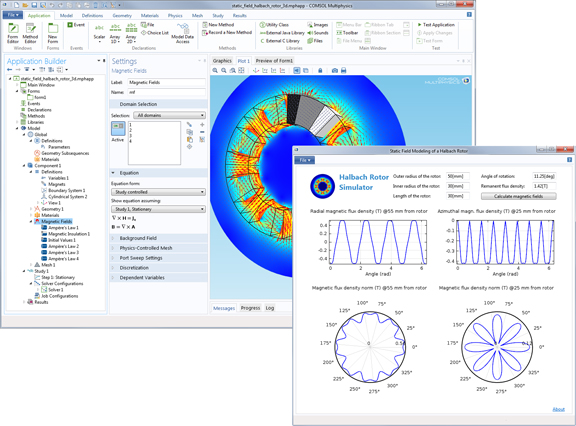
This application was created using a model of a halbach rotor and the Application Builder available in COMSOL Multiphysics®. The user can test different rotor geometries and analyze the resulting magnetic field distribution.
Latest News
October 9, 2014
 This application was created using the Application Builder available in COMSOL Multiphysics 5.0 and a model of a Li-ion battery pack. The background screen shows the expert’s use of COMSOL Multiphysics to perform the simulation. The foreground shows a much more simplified app with limited input fields that non-experts may use to test different operating conditions, battery geometries, and other parameters in order to find the desired thermal behavior.
This application was created using the Application Builder available in COMSOL Multiphysics 5.0 and a model of a Li-ion battery pack. The background screen shows the expert’s use of COMSOL Multiphysics to perform the simulation. The foreground shows a much more simplified app with limited input fields that non-experts may use to test different operating conditions, battery geometries, and other parameters in order to find the desired thermal behavior. Background screen shows how an expert might use COMSOL Multiphysics 5.0 to simulate rotor magnetic field. Based on his or her calculations, the expert may also create an application, like the one shown in the foreground, to test different rotor geometries and analyze the resulting magnetic field distribution.
Background screen shows how an expert might use COMSOL Multiphysics 5.0 to simulate rotor magnetic field. Based on his or her calculations, the expert may also create an application, like the one shown in the foreground, to test different rotor geometries and analyze the resulting magnetic field distribution.It took COMSOL‘s R&D team an estimated 20 man-years (20 people working for a year) to develop the Application Builder, recalled Svante Littmarck, president and CEO of COMSOL. The big payoff for the hard work and effort that went into the project is the ease and efficiency with which simulation experts can share their knowledge with non-experts. Using the Application Builder, advanced simulation users can create specialized apps—for example, a bridge load calculator or a battery performance simulator—in a matter of minutes or hours.
The new feature is part of the upcoming release, COMSOL Multiphysics 5.0. It’s also the outcome of Littmarck’s vision of the future. He says, “[The Application Builder] brings the expertise of engineering specialists working in research and development to a greater majority of people, revolutionizing the product design process by allowing the power of multiphysics simulation to drive productivity and innovation. This is achieved by supplying those involved in the design and manufacturing process across all engineering disciplines with apps created by simulation experts.”
This week, attendees to the COMSOL User Conference in Boston got a preview of the Application Builder. Onstage demonstration reveals a template-driven approach with a mix of drag-and-drop operations users can employ to quickly turn sophisticated simulations into simpler apps with a few variables and input fields.
To simulate the way loads and stresses affect a complex bridge structure, for example, requires an advanced COMSOL user’s know-how. However, the same expert may use COMSOL Multiphysics 5.0’s Application Builder to create an app that can recalculate and dynamically update the stress distribution based on variable bridge width, height, and vehicle mass. This approach is the key to COMSOL’s strategy to make simulation more accessible to a broader audience.
The move to popularize simulation beyond the expert territory is ongoing. Some software developers bet on CAD-embedded simulation functions or CAD-friendly simulation packages to encourage design engineers to begin experimenting with simple stress and flow simulations. Others make simulation less intimidating to non-experts by repackaging higher-end simulation programs with fewer input fields and more automation. Both approaches have had successes.
By introducing a tool for the advanced users to develop simpler apps for their design-focused colleagues with limited simulation software skills, COMSOL avoids denying robust functionality to power users to attract a wider audience; it also avoids putting the burden to learn a general-purpose simulation software on the shoulders of average designers and engineers.
Apps created with COMSOL’s Application Builder can be run by others with COMSOL Multiphysics licenses. The company is also planning to release a COMSOL Server (release date not set yet), which raises the possibility that COMSOL Multiphysics users’ apps could be hosted like any other cloud-hosted apps so they can be accessed and run from mobile tablets or phones.
The first crop of apps built in the Application Builder will most likely be for internal use, driven by companies’ need to limit the use of the experts’ time and talent for repetitive or routine simulations. For instance, an expert may build a rotor static-field calculator app for the design department so he or she doesn’t have to provide the answer for every changes in rotor radius, length, rotation angle. But over time, with private and public cloud deployment, the use of COMSOL apps could expand beyond COMSOL users and even simulation software users.
For more on the type of apps you can publish with COMSOL App Builder, watch the video below:
Subscribe to our FREE magazine, FREE email newsletters or both!
Latest News
About the Author
Kenneth Wong is Digital Engineering’s resident blogger and senior editor. Email him at [email protected] or share your thoughts on this article at digitaleng.news/facebook.
Follow DERelated Topics






